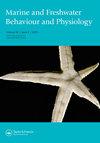暴露于高温、缺氧和两种情况下的青鲍鱼幼鱼的运动和能量消耗
IF 1.1
4区 生物学
Q3 MARINE & FRESHWATER BIOLOGY
Marine and Freshwater Behaviour and Physiology
Pub Date : 2023-09-21
DOI:10.1080/10236244.2023.2261607
引用次数: 0
摘要
摘要短期海洋极端气候导致绿鲍鱼(halotis fulgens)生物量损失严重,大量死亡。研究了绿鲍鱼在环境胁迫下的行为和能量消耗。采用自动化系统对适应后的幼鱼进行热疗(26°C)、缺氧(1.0 mg O2 L-1)、两者结合以及控制条件(18°C和氧饱和度)。通过标记和拍摄记录生物的运动参数,并在密闭室中测量呼吸速率。在总距离、净距离和速度上,控制组与组合应激源存在差异。呼吸因高温而升高,因缺氧而降低,并因联合应激源而进一步降低。所有在夜间离开避难所的鲍鱼都在白天返回,而缺氧和高温减少了这一数量。对环境应激和运动策略的研究可以带来更客观的应激代理。本研究由墨西哥国家科学委员会Tecnología(墨西哥)资助,项目编号CB 287237。技术支持由Gilberto González Soriano、Rosa Isela Vázquez Sánchez、Oscar A. Larrañaga Sosa和Samuel Calderón lisamuvanos提供。我们感谢Producción Pesquera de Bahía Tortugas s.c. de R.L.社会合作组织及其工作人员提供实验生物体。GICG获得CONACYT博士奖学金739928。披露声明作者未报告潜在的利益冲突。本研究由国家科学委员会通过Tecnología [CB287237]提供支持。本文章由计算机程序翻译,如有差异,请以英文原文为准。
Movement and energy expenditure in juvenile green abalone ( Haliotis fulgens ) exposed to hyperthermia, hypoxia, and both conditions
ABSTRACTGreen abalone (Haliotis fulgens) experienced severe biomass losses and massive mortality due to short-term marine climatic extremes. We studied green abalone behavior and energy expenditure in response to environmental stress. Acclimatized juveniles were subjected to hyperthermia (26°C), hypoxia (1.0 mg O2 L-1), the combination of both, and control conditions (18°C and oxygen saturation) using an automated system. The movement parameters of organisms were recorded by labeling and filming them, and the respiration rate was measured in hermetic chambers. There were differences in gross and net distance and velocity between the control and the combined stressors. Respiration was raised by hyperthermia, lowered by hypoxia, and further reduced by the combined stressors. All abalone that left the shelter during the night returned by daylight, while hypoxia and hyperthermia reduced this number. Research on environmental stress and movement strategies could lead to a more objective stress proxy.KEYWORDS: Behaviorclimate changebenthic ecosystemsecophysiology AcknowledgmentsThis work was supported by the Consejo Nacional de Ciencia y Tecnología (Mexico) under grant CB 287237. Technical support was provided by Gilberto González Soriano, Rosa Isela Vázquez Sánchez, Oscar A. Larrañaga Sosa, and Samuel Calderón Liévanos. We thank the Sociedad Cooperativa de Producción Pesquera de Bahía Tortugas S. C. de R.L. and their personnel for providing the experimental organisms. GICG received a CONACYT doctoral fellowship 739928.Disclosure statementNo potential conflict of interest was reported by the author(s).Additional informationFundingThe work was supported by the Consejo Nacional de Ciencia y Tecnología [CB287237].
求助全文
通过发布文献求助,成功后即可免费获取论文全文。
去求助
来源期刊

Marine and Freshwater Behaviour and Physiology
生物-海洋与淡水生物学
CiteScore
2.10
自引率
0.00%
发文量
9
审稿时长
>12 weeks
期刊介绍:
Marine and Freshwater Behaviour and Physiology is devoted to the publication of papers covering field and laboratory research into all aspects of the behaviour and physiology of all marine and freshwater animals within the contexts of ecology, evolution and conservation.
As the living resources of the world’s oceans, rivers and lakes are attracting increasing attention as food sources for humans and for their role in global ecology, the journal will also publish the results of research in the areas of fisheries biology and technology where the behaviour and physiology described have clear links to the contexts mentioned above.
The journal will accept for publication Research Articles, Reviews, Rapid Communications and Technical Notes (see Instructions for authors for details). In addition, Editorials, Opinions and Book Reviews (invited and suggested) will also occasionally be published. Suggestions to the Editor-In-Chief for Special Issues are encouraged and will be considered on an ad hoc basis.
With the goal of supporting early career researchers, the journal particularly invites submissions from graduate students and post-doctoral researchers. In addition to recognising the time constraints and logistical limitations their research often faces, and their particular need for a prompt review process, accepted articles by such researchers will be given prominence within the journal (see Instructions for authors for details).
 求助内容:
求助内容: 应助结果提醒方式:
应助结果提醒方式:


